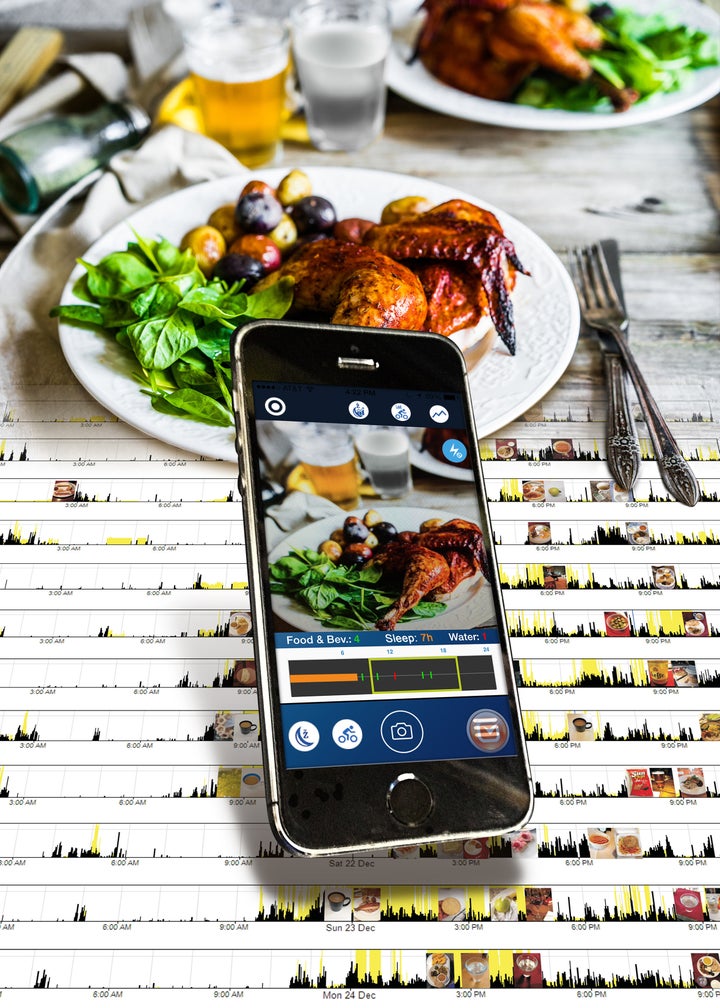
Like most people, you'd probably describe your eating schedule as three meals a day with perhaps a snack or two in between.
But a new research project that prompts people to record every bite and sip they take throughout the day might reveal some unsettling truths about the way you truly eat.
In a three-week study published in the journal Cell Metabolism, most participants claimed to eat three discrete meals a day, but the breakfast, lunch and dinner pattern was “largely absent." Instead, lead researcher Satchidananda Panda wrote, most people ate “frequently and erratically” throughout the day. About half of the participants grazed for fifteen hours a day.
“People eat as soon as they wake up and roughly eat as long as they are awake,” Panda told The Huffington Post. "This means they are fasting only when they sleep.”
That's particularly alarming given how little some Americans sleep. "This has a huge impact on how we interpret the data on sleep and obesity/diabetes,” Panda continued. "Since short sleep correlates with obesity/diabetes, it implies people who sleep less may be munching as long as they are awake."
Lest you think "grazing" refers to the "several small meals" dietary pattern that many weigh loss programs recommend, Panda found that more "eating hours" meant more calories. But perhaps more importantly, eating for so many of our waking hours could be disrupting our circadian rhythms -- the clock our bodies use to regulate sleep and metabolism, among other things.

The study, which evaluated the eating habits 150 healthy people, was conducted through an app called MyCircadianClock that was developed by Panda, a scientist at the Salk Institute for Biological Studies in La Jolla, California. But even though Panda's initial study is over, the MyCircadianClock app is still available for download, and research is ongoing.
How The App Works
Before eating or drinking anything, users take a photo of it with the app, and the photo, along with any typed notes, geolocation and other metadata, is sent to the researchers’ servers.
Sounds like a food journal, right? Journaling is an effective weight loss intervention because of the "feedback effect" -- seeing how much you eat, and what you eat, in a comprehensive list can influence people to eat less. But because the researchers wanted to record eating habits, rather than influence them, the app deletes the images from participants’ phones. The app also has fields for logging exercise, sleep, weight, blood pressure and blood glucose.
After a few weeks, scientists are able to identify dietary patterns, such as the aforementioned 15-hour eating schedule. For example, people averaged fewer than 25 percent of total calories before noon and 37.5 percent of calories after 6 p.m., revealing that more eating took place in the late afternoon and evening hours than any other time. The average amount of time between snacking and/or meals was about three hours, with the upper 25 percent eating about every six hours and the lower 25 percent eating every 1.5 hours.
And while most people started out with good intentions -- eating yogurt in the morning, for example -- researchers found that people also started in on chocolate and candy at 10 a.m. and continued eating sweets the rest of the day.
If Panda’s initial results are any indication, a lot of us are eating throughout every waking hour, only taking a break from food to go to sleep.
But because this is just a small feasibility study, the findings are not necessarily generalizable to the population. Panda hopes to eventually enroll a million Americans in MyCircadianClock, especially from diverse socioeconomic and demographic backgrounds. For instance, most of the people enrolled in this initial study worked in jobs with steady hours, but these patterns could be different if shift workers, students or the unemployed were part of the data set.
'Eating hours' may matter more than calories
After the first phase of the study, researchers randomly recruited eight of the original participants who ate more than 14 hours per day to take part in a four-week intervention study. This time, they were told to restrict eating to only 10 to 12 hours a day. This recommendation was based on previous rodent studies Panda conducted that found mice who ate a certain number calories across 12 hours, as opposed to mice who ate the same amount for more than 12 hours, had lower levels of fat mass, better sleep, increased endurance, reduced inflammation and slower cardiac aging.
Panda didn’t ask the group of eight to change the types of foods they ate, or eat healthier. Instead, all they did was restrict their eating hours while continuing to log their food and drink in the app.
Incredibly, the eight participants lost an average of seven pounds in four months. They also reported improved sleep satisfaction and energy levels. They continued their new eating schedule for the rest of the year and were able to maintain their weight loss and higher energy levels.
"Surprisingly, in the intervention study, people reported much better sleep at night and they wake up feeling rested and energetic in the morning,” said Panda. "This implies that eating early dinner and avoiding food at least a few hours before going to bed might help people sleep better." However, Panda doesn't want to suggest that everyone should eat this way, as the schedule could be dangerous for people with hypoglycemia -- low blood sugar.
Even though the participants didn’t change the content of their diet, Panda confirms that reducing the hours they ate resulted in the reduction of about 20 percent of calories, which may be one reason why they were able to lose weight. But the scientist also speculates that aligning our eating patterns to the ancient, 12-hour rhythms of sleep and wakefulness may help prevent or even reverse the beginnings of metabolic diseases like obesity and insulin resistance. When we disrupt this rhythm — say, by continuing to eat when our body thinks we should be fasting and resting — we could be setting the stage for weight gain and other health problems.
"Humans and animals have lived for millions of years with [a] daily cycle of feeding and fasting,” wrote Panda. "Accordingly, we all have developed a timing system or circadian clock to turn on and off thousands of genes at the right time of the day to tune our physiology and metabolism."
Enrollment for MyCircadianClock is ongoing, and Panda encourages anyone who wants some insight into their eating habits in exchange for their research data to download the app.
If you're curious but unready to commit, tune in next month: A Healthy Living editor is currently trying the app and will report back with observations and insights.
Also on HuffPost:
